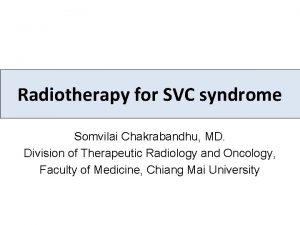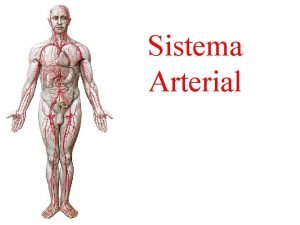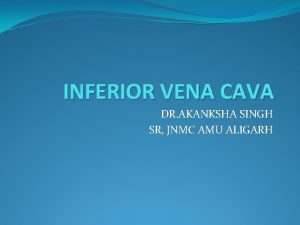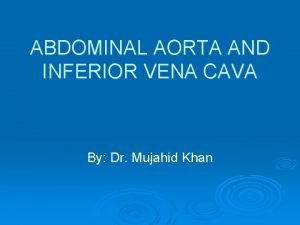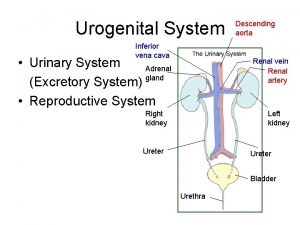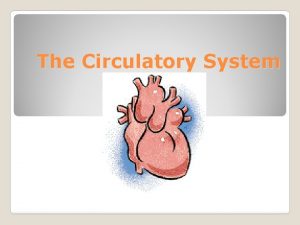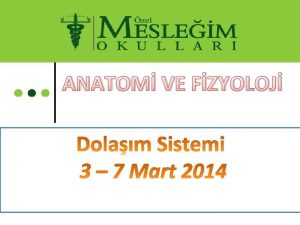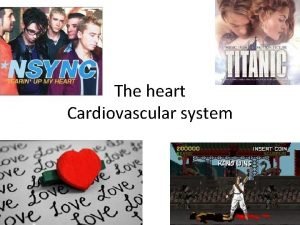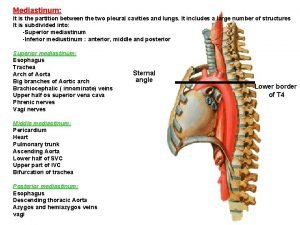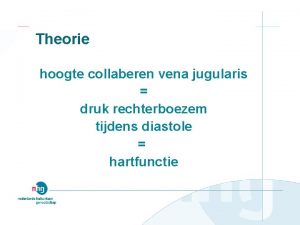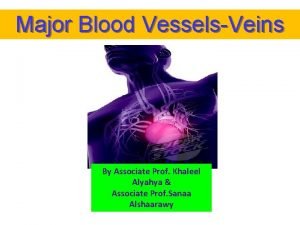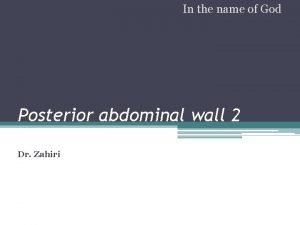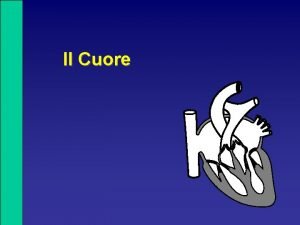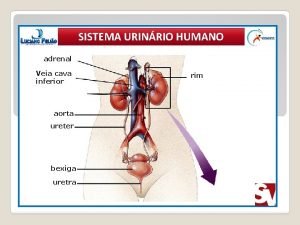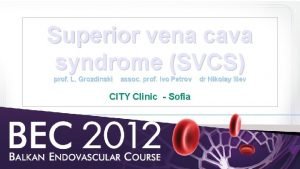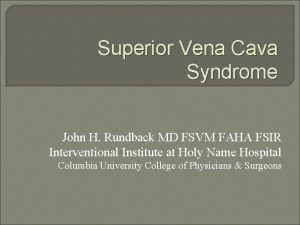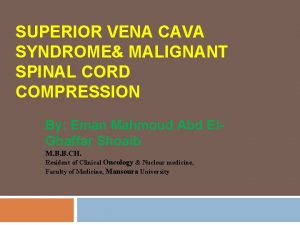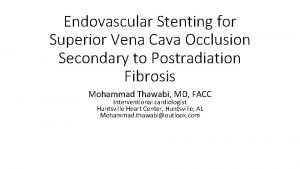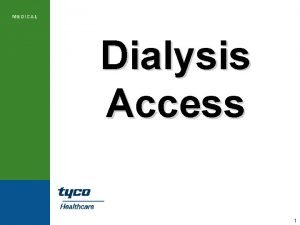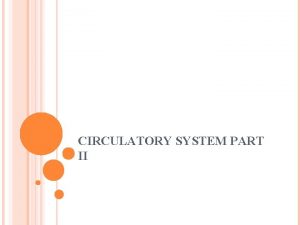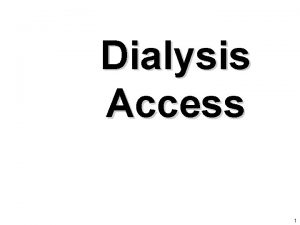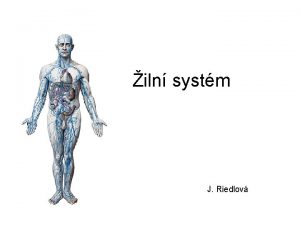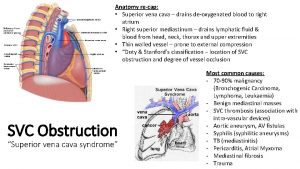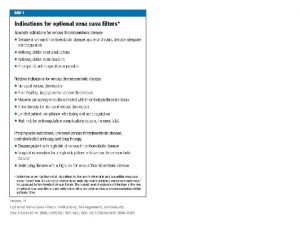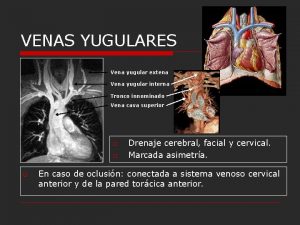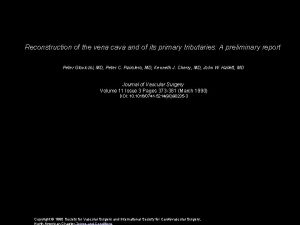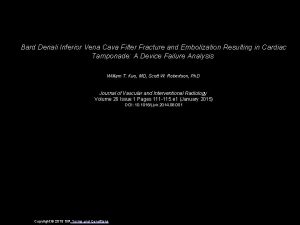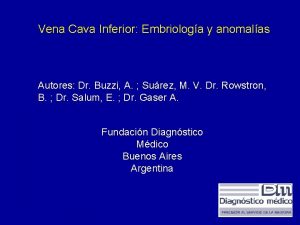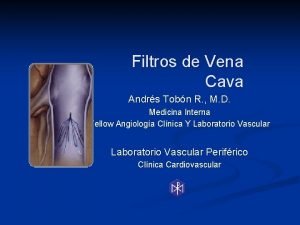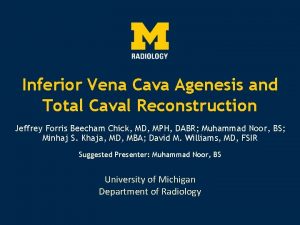Management of Superior Vena Cava Syndrome Perspective from
































- Slides: 32

Management of Superior Vena Cava Syndrome Perspective from vascular surgery Joint Hospital Surgical Grand Round Dr NG Kit Yu Albert Tuen Mun Hospital 27 th October 2012

Case Presentation • 54 years old gentleman • Case of end stage renal failure on haemodialysis • Right brachial artery to cubital vein arteriovenous fistula (AVF) creation complicated by graft infection with graft removal • Left brachial artery to median cubital vein AVF creation, complicated with AVF stenosis with angioplasty done • Multiple episodes of temporary catheter insertion over neck

Case Presentation • Complained of rapid increase in facial swelling and dyspnea, clinically compatible with SVCO • CT venogram done – left brachiocephalic vein near complete obstruction – right brachiocephalic vein complete obstruction – superior vena cava obstruction


Case Presentation

Causes of SVCS • Malignant (80 -90%) – bronchogenic carcinoma – metastatic pulmonary malignancy – metastatic mediastinal malignancy – lymphoma – leukaemia • Benign (10 -20%)

Causes of SVCS • Benign – mediastinal fibrosis – vascular diseases • e. g. aortic aneurysm, large-vessel vasculitis – infections • histoplasmosis, tuberculosis, syphilis, actinomycosis… – benign mediastinal tumors • teratoma, cystic hygroma, thymoma, dermoid cyst… – thrombosis from central venous catheters, pacemaker leads, and guidewires

Presenting signs and symptoms Oncologic emergencies, Michael T. Mc. Curdy et al Crit Care Med 2012 Vol. 40, No. 7

Imaging for SVCS • CT – identify pathology and extent of involvement – demostration of collaterals • MRI • Doppler ultrasound – identify thrombosis – reverse flow in subclavian vein • Venogram

Treatment options • Malignant causes – supportive measures • e. g. head elevation, fluid restriction, diuretics – chemotherapy – radiotherapy – corticosteriods – endovascular intervention – surgical bypass

Treatment options • Benign causes – supportive measures + treat underlying causes – thrombolytic therapy followed by anticoagulation • for acute thrombotic event <2 days • successful thrombolysis was demonstrated in 70% of the patients – endovascular intervention – operative bypass

Endovascular intervention for SVCS • Venoplasty and venous stenting • Provide rapid relief of symptoms – 24 -72 hours after placement • Restoration of a diameter of 12 to 14 mm resolves symptoms • Primary patency rates at 12 months are between 17% and 30% for angioplasty alone – secondary interventions are frequently necessary after PTA alone

Carlos Lanciego et al Endovascular Stenting as the First Step in the Overall Management of Malignant Superior Vena Cava Syndrome

Endovascular intervention for SVCS • Vascular stent for SVCO in NSCLC patients • Retrospective study involving 17 patients Laurent Greillier et al Respiration 2004; 71: 178– 183

Endovascular intervention for SVCS • Outcome – malignant SVC syndrome • Nagata et al. , 71 patients • primary and secondary patency rates of 88% and 95% • over a mean survival period of 5. 4 months Nagata T, Makutani S, Uchida H, Kichikawa K, Maeda M, Yoshioka T, Anai H, Sakaguchi H, Yoshimura H. Follow-up results of 71 patients undergoing metallic stent placement for the treatment of a malignant obstruction of the superior vena cava. Cardiovasc Intervent Radiol 2007; 30: 959– 67.

Safety and effectiveness of vascular endoprosthesis for malignant superior vena cava syndrome N P Nguyen et al Thorax 2009; 64: 174– 178

Endovascular intervention for SVCS • Outcome – benign SVC syndrome • Bornak et al. , 9 patients – one-year patency of 67% – two patients requiring repeated interventions for recurring symptoms • Sheikh et al. 19 patients – mid-term patency of 93% with a median followup of 29 month – three patients requiring repeated interventions

Endovascular intervention for SVCS • Complications – airway compromise, pulmonary embolism – superior vena cava rupture, hemoperiocardium and tamponade – stent related • malposition, migration, fracture – access site related – anticoagulation related – average: minor 3. 2%, major 7. 8% • Ganeshan et al. , superior vena cava stenting for SVC obstruction: current status

Endovascular intervention for SVCS Safety and effectiveness of vascular endoprosthesis for malignant superior vena cava syndrome N P Nguyen et al Thorax 2009; 64: 174– 178

Endovascular intervention for SVCS • Rapid relief of symptoms • Studies limited to case reports and small series only • Lack of results of long term follow up • Questions to ask – long term results for benign cases? • long term sequlae with stent in situ – balloon only or + stent in benign cases?

Venous bypass for SVCS • Reserved for patients whose symptoms are refractory to anticoagulation and endovascular treatment • Internal jugular to right atrium / SVC bypass – spiral saphenous vein graft – expanded polytetrafluoroethylene graft • Extra-anatomical bypass

Venous bypass for SVCS • Extra-anatomical bypass – internal jugular / axillary vein femoral / external iliac vein – avoid sternotomy • morbidities • avoid mediastinal pathology

Management of Superior Vena Cava Syndrome by Internal Jugular to Femoral Vein Bypass Rajinder Singh Dhaliwal et al Ann Thorac Surg 2006; 82: 310– 2

Venous bypass for SVCS Superior vena cava syndrome: Relief with a modified saphenojugular bypass graft Jean M. Panneton et al J Vasc Surg 2001; 34: 360 -3

Venous bypass for SVCS • Studies limited to case reports and small series only • Not much recent data in view of increasing expertize in endovascular intervention • Still a feasible treatment option if other treatment modalities failed • Questions to ask – comparison between traditional “open heart” vs extra-anatomical bypass?

Case Presentation • Venoplasty + stenting planned • Intra-operative findings – right brachiocephalic vein was completely occluded from origin – left brachiocephalic vein about 2 cm tight segmental occlusion, about 5 -6 cm from origin – failed cannulation and subsequent procedure

Case Presentation • Left axillary vein to left external iliac vein bypass performed – bypass with 8 mm ring supported PTFE graft • Post-op well with head and neck swelling subsided slowly • Follow up 2 months post-op – head and neck swelling much subsided – doppler signal over graft +ve

Case Presentation

Case Presentation

Summary • Superior vena cava syndrome – uncommonly need vascular intervention – endovascular intervention showed promising results in published data – operative bypass as last resort

Thank you

Etiology of central vein thrombosis in HD patients • Mechanical injury from either repeated catheter insertion or continuous catheter movement inside the vein invoking endothelial damage, subsequent inflammation, intimal hyperplasia, and fibrosis • Catheter or AVF related changes in the flow dynamics leading to increased shear stress, platelet aggregation, and intimal hyperplasia • Number of catheters inserted and increased duration of catheter days are associated with the development of thrombosis
 Causes of superior vena cava syndrome
Causes of superior vena cava syndrome Sistema venoso
Sistema venoso Left atrium sheep heart
Left atrium sheep heart Inferior vena cava relations
Inferior vena cava relations Pearson education inc
Pearson education inc Development of superior vena cava
Development of superior vena cava Dr demeter judit
Dr demeter judit Aorta vena cava
Aorta vena cava Abdominal aorta and inferior vena cava
Abdominal aorta and inferior vena cava Inferior vena cava urinary system
Inferior vena cava urinary system Function a
Function a Vena cava inferiora katılan venler
Vena cava inferiora katılan venler Aorta and pulmonary artery
Aorta and pulmonary artery Trabeculae carneae
Trabeculae carneae Infundibulum of right ventricle
Infundibulum of right ventricle Mediastinum inferior
Mediastinum inferior Sistema urinario o excretor
Sistema urinario o excretor Veneuze boog
Veneuze boog Hepatic portal system diagram
Hepatic portal system diagram Kupfer zellen
Kupfer zellen Vena sovraepatica
Vena sovraepatica Inferior vena cava relations
Inferior vena cava relations Vena cava sup
Vena cava sup Vena cava inferiore
Vena cava inferiore Retrocoecal
Retrocoecal Scholar
Scholar Plica vena cava
Plica vena cava Marta adorno
Marta adorno Posicion tacto rectal
Posicion tacto rectal Superior canal dehiscence syndrome symptoms
Superior canal dehiscence syndrome symptoms One point perspective door
One point perspective door Silo perspective vs business process perspective
Silo perspective vs business process perspective Veia cava inferior e adrenais
Veia cava inferior e adrenais
